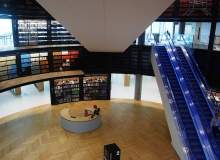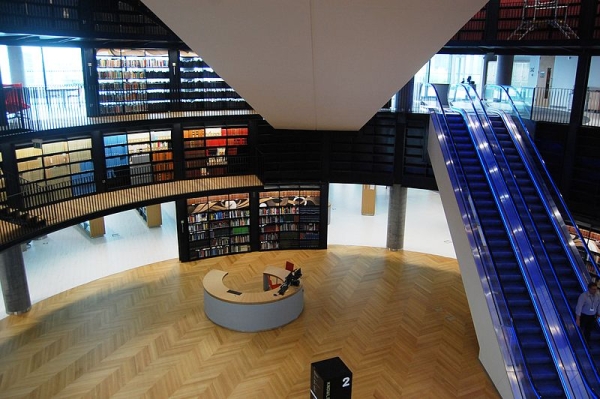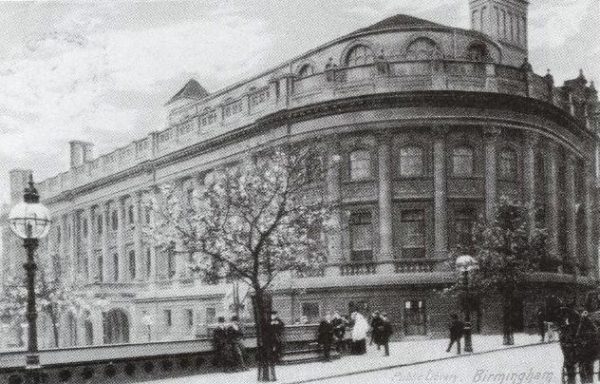

Between budget cuts and the growing popularity of e-books, it is easy to see why some believe the death knell has already sounded for public libraries, but we should not be too swift to view these august municipal institutions as inescapably condemned to extinction.
Libraries evolve. The existence of public libraries at all in an age when physical books – never mind e-books – are being sold at heavily discounted prices online and in supermarkets is testimony to their enduring ability to change with the times, embrace technology and assimilate new ideas. They may not always be among the first adopters, but they are undeniably adapters, and sometimes – as the newly-opened £188m Library of Birmingham shows – they position themselves firmly ahead of the curve.
Birmingham’s flagship library project
After an intense international competition which generated more than 100 tenders, Dutch architects Mecanoo were charged with realising library director Brian Gambles’ vision of a 21st century facility that is "no longer solely the domain of the book; it is a place with all types of content and for all types of people".
Occupying a prime site in the heart of Birmingham – on Centenary Square between the 1960s concrete-built Birmingham Repertory Theatre (The REP) and the 1936 Art Deco-style listed Baskerville House – the library is intended to form the flagship of the council’s ‘Big City Plan’ for regeneration.
Mecanoo’s Francine Houben describes the design as setting out to define a clear identity for the square and bring cohesion and atmosphere to it. It "transforms the square into one with three distinct realms: monumental, cultural and entertainment. These palazzos form an urban narrative of important periods in the history of the city."

US Tariffs are shifting - will you react or anticipate?
Don’t let policy changes catch you off guard. Stay proactive with real-time data and expert analysis.
By GlobalData‘Ode to the circle’
Houben set out to build anything but ‘just another glass building’ and as a result of that intent arguably the building’s most striking feature is its façade. A dual overlay of interlocking, metallic circles cover the elevations, which have been widely reported as inspired by the artisan tradition of this once-industrial city, but for which Houben readily concedes "every visitor – every Brummie – can provide their own interpretation".
In any case, she points out that the façade was primarily designed from within, to allow the changing shadows it generates inside the glass structure to contribute to what she calls the building’s "ode to the circle". The interior itself is formed from a sequence of eight circular, interlocking rotundas – with the book rotunda at its core – across several floors, each providing natural light and ventilation and connected by a series of travelators and escalators.
Beyond, two terrace gardens overlook the city, while an outdoor performance space extends into the square in front, below the cantilevered canopy that forms a shared entrance for the library and the REP.
As a building it is clearly a major step-change from the triumph of British brutalism that its predecessor, the Birmingham Central Library, represents, but designing libraries in the digital age brings challenges quite beyond the architectural.
The challenge of the digital age
The internet may have revolutionised the way many of us access information, but it has not changed the fundamental need that all of us have for it. According to the Q3 2013 figures from the UK Office of National Statistics, published in November, some seven million adults – around 14% of the adult population – had still never been online.
The headline figure may well be that 83% of UK households have internet access; it still means that 17% – some 4.3 million homes – do not.
The digital divide is not merely an issue between the developed world and emerging nations, it is one for the whole of modern society, and it’s a gap that public libraries could undoubtedly help to bridge.
According to the Pew Research Center, 26% of Americans over the age of 16 use either their local library’s computers or free WiFi connection to go online – two-thirds for school or work-related research, nearly half to obtain health information and almost as many to find out about government services.
Move away from the perception of a library as a stockpile of books and view it in its social context – as a community’s gateway to information, education and the digital world – and it is clear that the public library will retain all these roles, no matter how the format of what we read changes.
Changing reading habits?
The rise of e-books has been astounding. In 2009, they accounted for 2.7% of total book sales, according to Pricewaterhouse Coopers; just three years later, e-book sales made up 14.9% of the book market worldwide – and predictions suggest this could approach 18% by 2016.

The city’s old library
The US leads the way, with e-book sales achieving around 40% growth in 2013 alone – but drill deeper into the statistics, and the story is a little different. According to studies, only 20% of Americans actually use e-readers, and while one in ten of those who do will abandon print books altogether, generally e-reader owners simply read more – of both formats.
In one survey, on any given day, owners of e-books were found to be more likely to be reading the physical medium than the digital, and of all those who read e-books, 88% read physical ones too.
It seems our reading habits are not changing quite as much – or as quickly – as the proponents of Kindle and Kobo might wish us to believe. Our ‘Victorian’ love of real books and bricks-and-mortar libraries appears to have held strong in the modern age.
21st century library
Thus, books remain at the heart of Birmingham’s new library. More than 400,000 of them will be available to visitors to its 30,000m² interior, but Mecanoo’s approach does nevertheless contain some significant shifts from traditional library design.
Archives are no longer hidden in the basement, but put on display; there are multiple ‘ground floors’ to accommodate the predicted 10,000 visitors a day; there is space for events, activities and performance, and digital access – both from and to the library – is built-in.
The library reflects the needs of the modern age beyond how it will be used. The layout has been expressly designed to be family-friendly and provide maximum ease of access, while the building itself is BREEAM Excellent-rated, incorporating grey water recycling, ground source heat pumps and sun shading to reduce its environmental impact.
Such are the requirements of a library in the 21st century – and it seems they have been well met. Birmingham has built libraries before; whether this latest addition to the skyline will itself one day be replaced, of course, remains to be seen, but right now, the Library of Birmingham makes a bold statement of intent for the future of the city, and for libraries everywhere.
Related content
Digging into Mexico City’s Earthscraper
BNKR Arquitectura’s Earthscraper concept aims to address Mexico City’s residential problems with a 300m underground pyramid.
Vertical village: the future of high-rise living
The vertical village concept offers a vibrant alternative to drab and dreary residential tower blocks.



